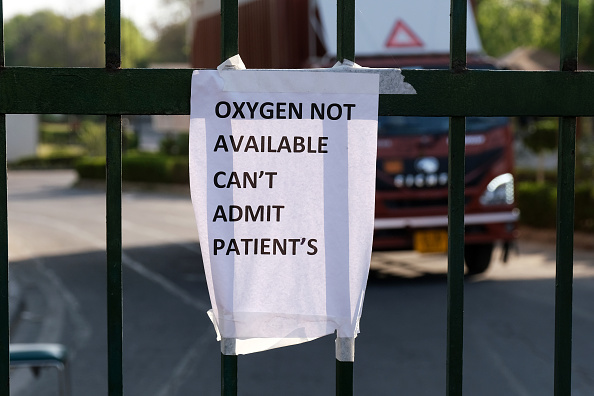
Punjab police personnel making announcement to shopkeepers to close their businesses before 5 p.m as per new COVID-19 night curfew orders by the state government, at Hall Bazar in Amritsar, India, April 27, 2021. /Getty
Punjab police personnel making announcement to shopkeepers to close their businesses before 5 p.m as per new COVID-19 night curfew orders by the state government, at Hall Bazar in Amritsar, India, April 27, 2021. /Getty
Editor's note: Thomas O. Falk is a London-based political analyst and commentator. He holds a Master of Arts in international relations from the University of Birmingham and specializes in U.S. affairs. The article reflects the author's opinions and not necessarily the views of CGTN.
India is currently a warning example for a nation that stopped taking the pandemic seriously. The government had promised that the worst was over. Now, India is facing a second wave that it will only overcome with international help.
One must admit that Prime Minister Modi missed the window to prepare his country efficiently for this new wave.
Instead, over these past months, people in India have been told that the worst was over and that the so-called herd immunity would be achieved by the end of the year.
The reality now looks fairly different.
With almost 352,991 people testing positive on April 26 alone, India posted a new daily record of COVID-19 newly infected people. In total, 17.6 million have been infected in the country and almost 200,000 have died. The trend is rising sharply. In the grand scheme, it may not seem a lot, given that India is home to 1.3 billion people, but the situation is continuously deteriorating.
All over the country, there are currently harrowing situations in hospitals because the health system is collapsing. The situation in the capital New Delhi is particularly dire. Medical oxygen and medication are scarce in many hospitals.
The number of people infected here is almost guesswork.
Different aspects have led to the crisis. On the one hand, a variant of the coronavirus, B.1.617, is to blame for the high number of cases. This double mutant is presumably more contagious, and immunization is likely weakened.
However, the fact that the virus has been able to spread rapidly in recent months is not only due to the mutations, but the fact that the Indian government allowed for mass events in sports and religion to take place for political purposes amid the pandemic and the looming second wave.
It also relaxed most of the requirements at the beginning of the year. As a result, people became increasingly complacent. Temporary COVID-19 isolation centers were shut down; social distancing and lockdown rules were eased; distance and mask rules were largely ignored.

A notice on a gate indicates that there is no oxygen at the COVID-19 Care Center set up at the Commonwealth Games (CWG) Village Sports Complex in New Delhi, India, April 25, 2021. /Getty
A notice on a gate indicates that there is no oxygen at the COVID-19 Care Center set up at the Commonwealth Games (CWG) Village Sports Complex in New Delhi, India, April 25, 2021. /Getty
During that time, the COVID-19 crisis seemed to be almost over, an extensive vaccination campaign was started, and at the same time, neighboring countries were being supplied with the vaccine.
However, while many believe that the government's crisis management was working, the new virus variant was already rising. Although it was apparent that India could not avoid a new wave either – the government miscalculated.
For example, at one of the largest religious celebrations in the country, an estimated 25 million pilgrims huddled together between January and mid-April, many without a mask. There were also election campaign events in many states, including one by Prime Minister Modi in Kolkata with an estimated 800,000 participants.
It wasn't until April 20 that Modi announced that people should stay home to prevent another lockdown. He described the second COVID-19 wave in a radio address to hit his country as a storm that "has shaken the nation."
Unfortunately, it was too late by then.
The result? India's healthcare has collapsed under the burden of the coronavirus. The health system, which has been underfunded for decades, is overwhelmed by the high number of COVID-19 patients, including a lack of oxygen, medication and beds. Doctors hardly get any sleep and run out of energy.
But even the equipment used in hospitals is currently at the limit. The previous week, 22 COVID-19 patients died in Nashik when their ventilators lost their oxygen supply due to a leak, to name one example of the dire situation.
Fortunately for India, several nations and organizations have already committed to helping the country.
China, the UK, Germany, the U.S. and the WHO and others will assist the Indian government by sending supplies such as ventilators.
Meanwhile, for Modi's governing Bharatiya Janata Party (BJP), it might be challenging to overcome the criticism it now increasingly faces. Even the most loyal supporters will wonder why India is directly dependent on help from abroad, considering that previously more than 60 million vaccine doses have been exported and only 50 million have been distributed in the country. Many of these doses will now be missed.
The devastation in India is a stark reminder of what can happen if the virus is underestimated and the necessary precautions are not being met. With a virus that continues to mutate and an insufficient level of immunity, the credo for these next months goes as follows: better safe than sorry.
(If you want to contribute and have specific expertise, please contact us at opinions@cgtn.com.)

